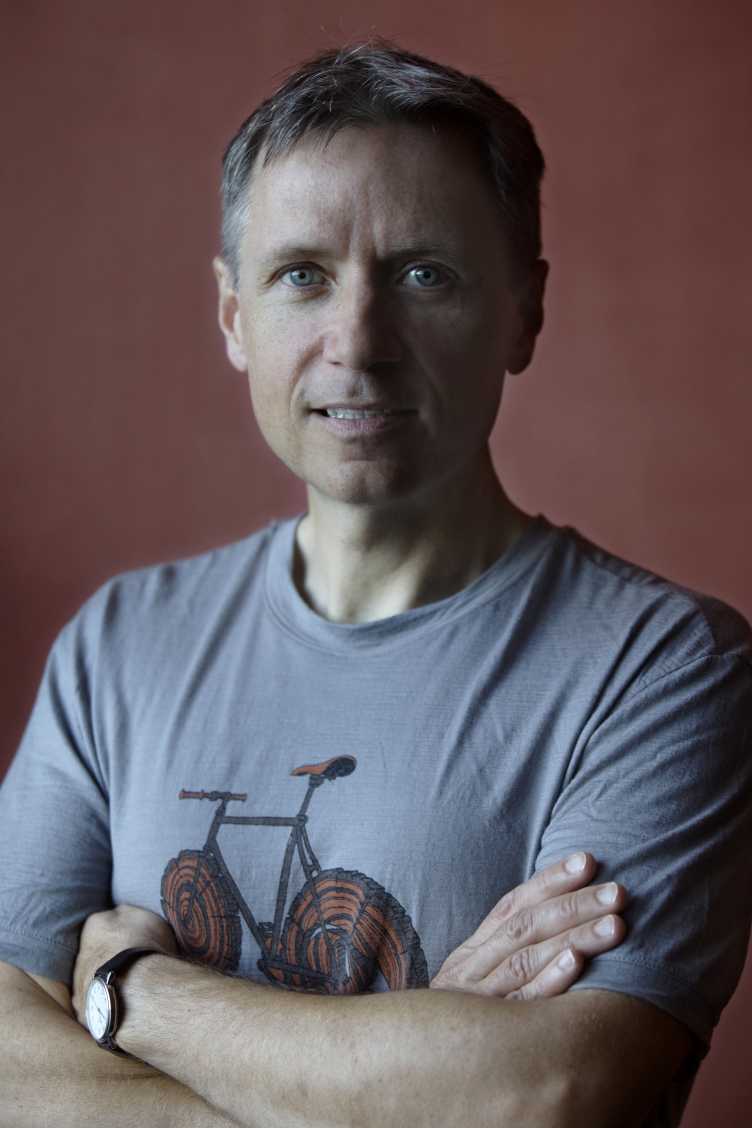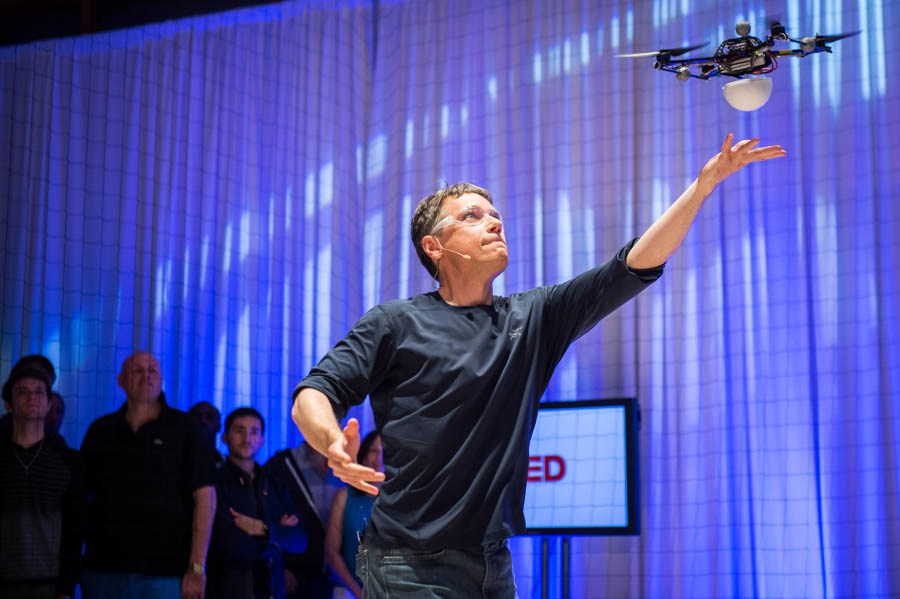La Bella Vita
The Robotics Industry Association presents ETH Professor Raffaello D'Andrea along with entrepreneur Dean Kamen one of the robotics industry's most prestigious honours – the 2015 Engelberger Award for Technology. What are the secrets behind his success?
Raffaello D'Andrea walks into his office, a sparkle in his eyes, having just come from a meeting where he and colleagues in the Department of Information Technology and Electrical Engineering (D-ITET) have envisioned a future collaboration in systems and control. He sits down at a table in front of the bookshelves where all of his books are stacked horizontally. "It makes sense this way," he explains. "You see, the titles of the books are printed on the spine. How many times have you seen someone contort their neck to find a book title when they are placed on the shelves vertically?" This is the first indication of how efficiency and natural order have shaped his life and work.
On Monday, 23 March 2015, The external pageRobotics Industry Associationcall_made presents Raffaello D'Andrea, Professor of Dynamic Systems and Control at ETH Zurich along with entrepreneur Dean Kamen one of the robotics industry's most prestigious honours – the 2015 Engelberger Award for Technology. Representing Switzerland, D’Andrea becomes one of six people in the country to have received an Engelberger Award and the first to be honoured with the award in the Technology category.
Most academics that have received the Engelberger award receive it in the category for Education, but the Technology award acknowledges D’Andrea's contribution not only to academia, but also to industry and the arts. While some of his projects are appreciated as art - like the robotic chair that he worked on with Canadian artists, Max Dean and Matt Donovan, D’Andrea did not set out to bridge the gap between science and art. “I view all of my work as the same, whether it appears at the Venice Biennale or Kiva Systems, it is the act of creation that I care about most," he says.
Acrobats – Inspiration for Dynamic Systems
D’Andrea's research team is highly focused on exploring the question of how to create autonomous systems and machines using information that one senses about the world – systems that can make decisions on their own or collectively learn faster. In the past seven years at ETH Zurich, D’Andrea and his team have worked on seven different types of projects from blind juggling machines to flying robots and from balancing cubes to a distributed flight array. "The inspiration for such projects comes from life - the need to explore visual or auditory patterns, to solve control problems, or simply from observation," says D’Andrea. He revealed that the inspiration for the balancing cube was a Cirque du Soleil performance called, "The Statue Act" in which acrobats had to use each other for balance to accomplish something that neither would be capable of doing on their own.
Engineering + Robotics = Opportunity
Recognition, like the Engelberger Award, demonstrates the "real world" contribution to technology and validates ETH Zurich's model for teaching and research. One might think that a technology award is a sign of an applied research model, but D’Andrea and his team engage in abstract non-application focused research on systems. "This award demonstrates that fundamental research can still have a substantial impact on technology," he commented.
While he teaches both at the graduate and undergraduate level, with his doctoral students he views his role as someone who seeds ideas - giving energy to a gap in scientific knowledge or to an engineering problem. His team has explored the complex aerodynamics of flying machines creating algorithms that leverage the things readily understood and challenge the limits through trial, error, and adaptation. Creating algorithms that enable robots to learn and adapt made Kiva Systems, a company D’Andrea co-founded, one of the most innovative companies in the world.
It is not just D’Andrea's small team of 10 that conduct robotics-related research at ETH Zurich. There is a broad spectrum of research opportunities from collective learning to Nano devices and from biomedicine to new materials and autonomous aerial vehicles. The university's Institute of Robotics and Intelligent Systems (IRIS) encompasses the Multi-Scale Robotics Lab of Brad Nelson; the Autonomous Systems Lab of Roland Siegwart; Sensory Motor Systems Lab of Robert Riener; and the Agile and Dexterous Robotics Lab of Jonas Buchli and many others who are part of the Mechanical and Process Engineering Department.
Research Heaven
D’Andrea has an international perspective on research having studied or worked at Caltech, Cornell, and MIT. "From a professional perspective I have always felt, but am now convinced that ETH Zurich is the best place to do engineering research in the world. We are given incredible support in terms of resources and academic freedom. Because the Swiss government and the European Union, in general, recognize the importance of fundamental research and funds researchers well, so we are able to do top notch work at ETH," says D’Andrea.
More than 750 professors, scientific staff, and students recruited from the U.S., currently teach, research, or study at ETH Zurich. There is a meritocracy at ETH Zurich that makes it different from other universities – tuition rates are low making it an attractive place for the talented to progress based on merit rather than class. D’Andrea observes, "When people realize that they can spend time conducting fundamental research on a long-term horizon, without the pressure of chasing grant funding, writing research proposals, and bending to the research agendas of funding agencies - professionally it is a dream come true. If you are a scientist, student, or researcher this is the place to follow your dreams and we attract among the best students in the world."
Secrets to Success

Italians seem to be born with an innate passion for life. Culturally, they have nearly perfected the ability to really create “la bella vita” - the beautiful life. Born just outside of Venice, D’Andrea is no exception. So what are his secrets? How does someone who has garnered such success balance the pressures of academic life and professional commitments with family?
He attributes the balance, in part, to his great team and finds it mutually beneficial to provide them with opportunities to develop professionally, to participate in conferences and speak about their work. D’Andrea's deep appreciation of nature - for its order, cleanliness and efficiency sends him into the mountains once a week for inspiration. When he was growing up just outside of Toronto, Canada he didn't have just one mentor, but sought to adopt the positive aspects of people he met. "I have a 2 ½ year old child who is a significant influence in my life right now," he says. She laughs a lot. In fact everything in life is a joy to her right now and when I try to see things from her perspective, it is wonderful inspiration."
One of the most surprising secrets of D’Andrea's success is the fact that he limits technology in his personal life. He was a late adopter of the smart phone and does not maintain any social media accounts. Much like the systems he researches in his work, he says, "I like simplicity, robustness, and independence. Sometimes technology makes us too dependent and when we embrace it too much we lose certain skills and experience a decrease in productivity." On life he advises, "Success requires hard work. If you are gifted with technical aptitudes, make the most of them; however, become an engineer only if you really enjoy technical work or are innately curious about science – passion is what yields a successful career and a happy life."

